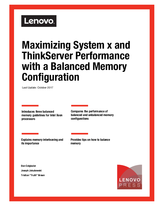Abstract
Configuring a server with balanced memory is important for maximizing its memory bandwidth and overall performance. Lenovo servers running Intel Xeon v3 or v4 processors have 4 or 8 memory channels per processor and up to three DIMMs per channel, so it is important to understand what is considered a balanced configuration and what is not.
In this paper, we introduce three balanced memory guidelines that will guide you to select a balanced memory configuration. Balanced and unbalanced memory configurations are presented along with their relative measured memory bandwidths to show the effect of unbalanced memory. Suggestions are also provided on how to produce balanced memory configurations.
This paper is for System x and ThinkServer customers and for business partners and sellers wishing to understand how to maximize the performance of Lenovo servers.
Table of Contents
Introduction
Memory interleaving
Balanced memory configurations
About the STREAM test
Memory topology
Applying the balanced memory guidelines - E5 processors
Applying the balanced memory guidelines - E7 processors
Maximizing memory bandwidth
Cluster on Die option impact on memory bandwidth
Summary
Change History
Changes in the 4 October 2017 update:
- Correction that one of the 6-DIMM configurations is balanced
Other Balanced Memory papers
This paper is one of a series of papers on Balanced Memory configurations:
- Balanced Memory Configurations with 4th Generation AMD EPYC Processors
- Balanced Memory Configurations for 2-Socket Servers with 3rd Gen Intel Xeon Scalable Processors
- Balanced Memory Configurations with 2nd Gen and 3rd Gen AMD EPYC Processors
- Balanced Memory Configurations with 2nd Gen Intel Xeon Scalable Processors
- Balanced Memory Configurations with 1st Generation Intel Xeon Scalable Processors
- Maximizing System x and ThinkServer Performance with a Balanced Memory Configuration
Related product families
Product families related to this document are the following:

